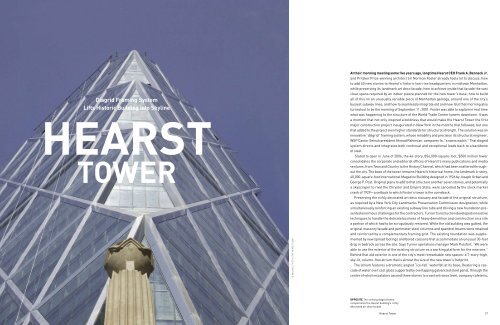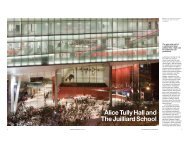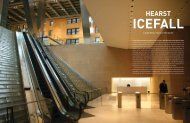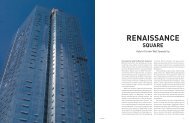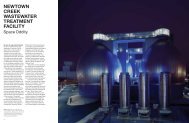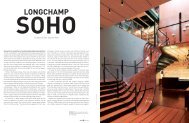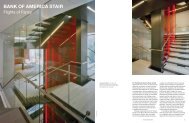Diagrid Framing System Lifts Historic Building into Skyline
Diagrid Framing System Lifts Historic Building into Skyline
Diagrid Framing System Lifts Historic Building into Skyline
You also want an ePaper? Increase the reach of your titles
YUMPU automatically turns print PDFs into web optimized ePapers that Google loves.
<strong>Diagrid</strong> <strong>Framing</strong> <strong>System</strong><strong>Lifts</strong> <strong>Historic</strong> <strong>Building</strong> <strong>into</strong> <strong>Skyline</strong>HearstTower© Michael Ficeto / The Hearst Corp.At their morning meeting some five years ago, longtime Hearst CEO Frank A. Bennack Jr.and Pritzker Prize-winning architect Sir Norman Foster already had a lot to discuss: howto add 40 new stories to Hearst’s historic low-rise headquarters in midtown Manhattan,while preserving its landmark art deco facade; how to achieve inside that facade the vastclear spans required by an indoor piazza planned for the new tower’s base; how to buildall of this on an unusually variable piece of Manhattan geology, around one of the city’sbusiest subway lines; and how to seamlessly integrate old and new. But that morning alsoturned out to be the morning of September 11, 2001. Foster was able to explain in real timewhat was happening to the structure of the World Trade Center towers downtown. It wasa moment that not only inspired a boldness that would make the Hearst Tower the firstmajor construction project inaugurated in New York in the months that followed, but onethat added to the project even higher standards for structural strength. The solution was aninnovative “diagrid” framing system, whose reliability and precision its structural engineer,WSP Cantor Seinuk president Ahmad Rahimian, compares to, “a swiss watch.” That diagridsystem directs and integrates both continual and exceptional loads back to a backboneof steel.Slated to open in June of 2006, the 46-story, 856,000-square-foot, $500 million towerconsolidates the corporate and editorial offices of Hearst’s many publications and mediaventures, from Town and Country to the History Channel, which had been scattered throughoutthe city. The base of the tower remains Hearst’s historical home, the landmark 6-story,40,000-square-foot International Magazine <strong>Building</strong> designed in 1926 by Joseph Urban andGeorge P. Post. Original plans to add to that structure another seven stories, and potentiallya skyscraper to rival the Chrysler and Empire State, were cancelled by the stock marketcrash of 1929—a setback to which Foster’s tower is the comeback.Preserving the richly decorated art deco statuary and facade of the original structure,as required by a New York City Landmarks Preservation Commission designation, whilesimultaneously reinforcing an existing subway line tube and driving a new foundation presentedenormous challenges for the contractors. Turner Construction developed innovativetechniques to handle the delicate business of heavy demolition and construction on a sitea portion of which had to be scrupulously restored. While the old building was gutted, theoriginal masonry facade and perimeter steel columns and spandrel beams were retainedand reinforced by a complementary framing grid. The existing foundation was supplementedby new spread footings and bored caissons that accommodate an unusual 30-footdrop in bedrock across the site. Says Turner operations manager Mark Pulsfort, “We wereable to use the exterior of the existing structure as a working platform for the new one.”Behind that old exterior is one of the city’s most remarkable new spaces: a 7-story-high,sky-lit, column-free atrium that is almost the size of the new tower’s footprint.The atrium features a dramatic angled “ice-fall” waterfall at its base, (featuring a cascadeof water over cast glass supported by overlapping galvanized steel pans), through thecenter of which escalators ascend three stories to a vast entrance level, company cafeteria,OPPOSITE The striking diagrid framecompliments the Hearst building’s richlydecorated art deco facade.20 Hearst Tower21
OPPOSITE TOP The 30-ton, 44-inchsquare“mega-columns” were assembledfrom 4-inch rolled steel plates.OPPOSITE BOTTOM Moment connectionat node joining primary members of thediagrid framing systemevent space, auditorium, and lobby. All of this is enabled by what engineer Rahimian calls,“the mega-columns”—twelve 30-ton, 44-inch-square box columns, assembled from 4-inchrolled steel plates, along with two 90-foot “mega-diagonals” of similar configuration. Grade50 steel members were used throughout, with 65 ksi elements in what Pulsfort calls, “thejumbo pieces.” A system of 40-ton beams at the tenth floor, integrated with skylights, formsa diaphragm that braces the structure laterally and ties the old building to the new. Butwhat sounds like a massive structural system achieves a surprising lightness, thanks to ashimmering pewter-like linen finish, 5-millimeter stainless steel cladding from Swedishfabricators Ovako, which also wraps the exterior structural system, adding that same subtleshimmer to the streetscape and skyline.If the spatial drama ends at ten stories up, that’s where the structural drama begins.Explains Rahimian, “Three sides of the building face streets and views, but the west side isagainst another building; so the decision was made to shift the core to the western edge,”like the spine at the back of a torso. While this enabled the spectacular atrium and clear20,000-square-foot floor plates above, it also meant that a central service core couldn’tbe used to symmetrically reinforce the eastern edge of the building. The solution was thediagonal grid, or diagrid system. Although typical steel moment-frame skyscrapers havelong used supplemental diagonal bracing systems to accommodate shear and distributegravitational loads, Rahimian explains that there is a difference between diagrid and normalbracing: “The diagrid doesn’t have a vertical element. The bracing accommodatesgravitational load as well as lateral, wind, and seismic loading. By virtue of its stiffnessand strength, it combines brace and column in one single element.” A system of 40-foot,BELOW Web framing beneath the atriumfloor laterally braces the “mega-columns.”All photos: © Michael Ficeto / The Hearst Corp.22 Spring 2006Hearst Tower23
All photos: © Michael Ficeto / The Hearst Corp.OPPOSITE The diagrid system is highlyredundant, providing multiple load pathsand a higher standard of performanceunder extreme stress conditions.ALL THIS PAGE The “mega-columns” andsimilar “mega-diagonals” support thetower above a 7-story-high atrium.24 Spring 2006Hearst Tower25
four-story triangular elements wraps around the building’s perimeter, turning the facade,Rahimian explains, “<strong>into</strong> basically a giant truss, formed as a tube <strong>into</strong> a very strong shell.”Above the tenth floor, the hardened-steel core ties <strong>into</strong> the facade structure: The systemallows broad interior spans of more than 40 feet between columns, as well as enabling atotal steel tonnage of only 12,000 tons, 20 percent less that what a conventional structuralsystem would have required. Most importantly, it’s a system with unusual resiliency relativeto its mass and scale. In Rahimian’s words, “The diagrid system is inherently highly redundantby providing a structural network allowing multiple load paths. This provides a higherstandard of performance under extreme stress conditions that national and internationalcodes are striving to achieve.” Indeed, Foster in collaboration with Rahimian proposed asimilar diagrid system for his acclaimed “Kissing Towers” entry in the 2002 World TradeCenter reconstruction competition, suggesting a similar geometry at precisely three timesthe scale.The diagrid required exceptional exactitude in the construction process. The requiredstiffness of the structure reduced allowable tolerances from a typical 5/8-inch rangedown, in some cases, to 1/8-inch—a range equaled in Manhattan perhaps only by YoshioTaniguchi’s famously precise 2004 addition to the Museum of Modern Art. “You can’t pulland rack it like a conventional structure,” says Pulsfort of the construction process he managed.“The node had to be right on the money.” Explains Rahimian, “We built a 3-D computermodel to determine how we expected the structure to flex and deflect under gravity load atdifferent stages of construction. It was a 3-D structural map over time.” The elements wereassembled by an innovative two-point crane pick that, explains Pulfort, “enabled each elementto be hooked, carried, and placed already at the right [75 degree or 105 degree] slope.”Cives Steel prefabricated wide-flange rolled steel sections <strong>into</strong> intricate 6-ton node connectors.In what the engineers called a “bird’s mouth” geometry at the building’s corners,these complex nodes bolted <strong>into</strong> six different 12-inch, H-column-type diagrid elements. Toachieve additional fine tolerances within the gutters and ridges of the stainless steel claddingat the nodes, ironworkers had to flip the heads and shafts of bolts on a case-by-casebasis. “The guys were happy,“ Pulsfort recalls, “when the first one worked.”In 1926, William Randolph Hearst demanded that his building be, “something with architecturalcharacter, with public character.” And though the original 6-story structure wenta long way in fulfilling that imperative, it hasn’t been until now, 80 years later, that Hearst’swish has been realized. Thanks to a designer’s vision, the precision of a construction team,and the pragmatic efficiencies and material strength of steel, the new Hearst Tower is avibrant addition to the Manhattan skyline, one that will surely work it’s way <strong>into</strong> the iconographyof the city in the century ahead.TOP Ironworkers connect the initial bolts ofa 6-ton node connectorABOVE Broad spans within the interiorreach to 40 feet or more.All photos: © Michael Ficeto / The Hearst Corp.HEARST TOWEROwner Hearst Corp. New York, NYDeveloper Tishman Speyer New York, NYArchitect Foster and Partners London, UKAssociate Architect Adamson Associates New York, NYStructural Engineer WSP Cantor Seinuk New York, NYGeneral Contractor Turner Construction New York, NYStructural Steel Fabricator Cives Steel Company Gouvernor, NYStructural Steel Erector Cornell and Company Westfield, NJMiscellaneous Metal Fabricators and ErectorsEmpire City Iron Works Long Island City, NYOrnamental Metal Fabricator and ErectorAllied Bronze LLC Long Island City, NYCoordinated Metals, Inc. Carlstadt, NJCurtain Wall Fabricator Permasteelisa Cladding Technologies LTD Windsor, CTCurtain Wall Erectors Tower Installation LLC Windsor, CT26 Spring 2006Hearst Tower27


